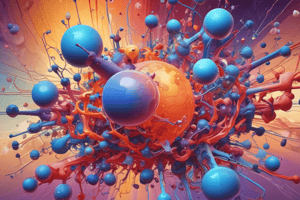Podcast
Questions and Answers
Match the following states of matter with their characteristics:
Match the following states of matter with their characteristics:
Solid = Relatively fixed shape and volume Liquid = Flows freely but maintains a definite volume Gas = No fixed shape or volume, expands to fill its container Plasma = Highly ionized and electrically conductive state of matter
Match the following phase transitions with their descriptions:
Match the following phase transitions with their descriptions:
Freezing = From liquid to solid state when temperature drops below melting point Melting = From solid to liquid state when temperature rises above melting point Vaporization = From liquid to gas state through evaporation or boiling Condensation = From gas to liquid state when vapor cools and changes back to liquid
Match the following bonding types with the states of matter they are commonly found in:
Match the following bonding types with the states of matter they are commonly found in:
Ionic Bonds = Common in solid-state materials Covalent Bonds = Present in solids and liquids, strong sharing of electrons Metallic Bonding = Typical in metals, contributes to solid-state structures Hydrogen Bonding = Weak bond in liquids like water, influencing properties
Match the following phase transitions with their temperature points for water:
Match the following phase transitions with their temperature points for water:
Match the following descriptions with the respective states of matter they refer to:
Match the following descriptions with the respective states of matter they refer to:
Match the following phase transitions with their descriptions:
Match the following phase transitions with their descriptions:
Match the following characteristics with the corresponding states of matter:
Match the following characteristics with the corresponding states of matter:
Match the following temperatures with the correct phase transitions for water:
Match the following temperatures with the correct phase transitions for water:
Match the following phase transitions with their impact on reactivity:
Match the following phase transitions with their impact on reactivity:
Match the following statements with the correct state of matter behaviors:
Match the following statements with the correct state of matter behaviors:
Flashcards are hidden until you start studying
Study Notes
States of Matter: Understanding Solid, Liquid, Gas, and Phase Transitions
Introduction
Matter can exist in various physical states, including solid, liquid, gas, and even plasma under extreme conditions. Understanding these states of matter and their transitions between them is crucial for numerous scientific disciplines, including chemistry, physics, and materials science. Let's delve into each state of matter and explore the phase transitions that occur between them.
Solid State
Solids are characterized by their relatively fixed shape and volume. The particles within solids are closely packed together, held in place by strong interactions such as ionic bonds, covalent bonds, or metallic bonding. Because of these tight-knit structures, solids typically have low vapor pressures and require significant energy input to change their phase.
Phase Transition: Freezing
The process of converting a liquid to a solid state is known as freezing. This occurs when the temperature drops below the material's melting point, causing the atoms and molecules to slow down and form a rigid structure due to the increased attractive forces between neighboring atoms and molecules. An example of this transition would be water turning into ice at 0°C, which is its freezing point.
Liquid State
Liquids possess a somewhat fluid nature, allowing them to flow freely but still maintain a definite volume. Their particle arrangements are more loosely packed than those in solids, permitting greater movement among individual particles. However, unlike gases, liquids retain cohesion because they experience weak intermolecular forces.
Phase Transition: Melting
When heat is applied to a solid substance, its particles gain kinetic energy, eventually reaching a point where they acquire sufficient velocity to break free from their positions. This results in the solid transforming into a liquid through a process called melting. For example, an ice cube will melt into water when exposed to temperatures above its melting point of 0°C.
Gas State
Gas molecules exhibit high levels of translational motion and occupy large volumes compared to their molecular size. They can expand freely without retaining any specific shape or volume. Gases evolve quickly to fill the entire space available to them, exerting equal pressure on all surfaces around them.
Phase Transition: Vaporization
The conversion of a liquid into a gaseous state involves the application of heat until the molecules achieve enough energy to overcome the attractive forces holding them together. This leads to the emergence of discrete gas molecules that can move independently. A common illustration of this phenomenon is water boiling into steam at its boiling point of 100°C under standard atmospheric pressure.
Phase Transitions and Reactivity
Phase transitions can significantly impact a material's chemical reactivity. As the state of matter changes, the intermolecular forces and particle arrangements alter, which in turn affect the availability of reactive sites for chemical reactions to occur. For instance, some substances exhibit enhanced reactivity in their gaseous form due to increased accessibility of active sites compared to their solid or liquid counterparts.
In summary, understanding the states of matter and phase transitions between them is essential for various scientific applications. By recognizing these physical transformations, one can predict the behavior of materials under different temperature and pressure conditions and tailor their properties accordingly.
Studying That Suits You
Use AI to generate personalized quizzes and flashcards to suit your learning preferences.




